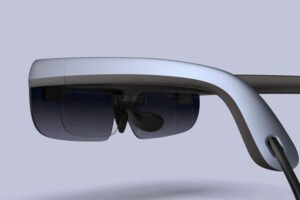1. AR Glasses Injection Molding Products formation of white lines
1.1 Microscopic explanation of white lines: When plastic is subjected to tensile stress, cavitation stripe-shaped deformation areas are generated due to stress concentration. These stripe plane areas strongly reflect visible light, forming a silver-white luster on the surface of the material, commonly known as white lines.
1.2 Characteristics of white lines: a. The average density is lower than the bulk density (the volume increases after being stretched); b. It can shrink or disappear after annealing, and it will become a crack if it deteriorates seriously.
1.3 Common white line locations: a. Near the parting surface of the product b. Around the penetration position c. Around the stopper position d. Sharp corners and water lines of the plastic parts
1.4 Several situations and causes of white lines: a. Insufficient clamping force b. Permanent deformation of the parting surface of the front mold large insert c. Excessive residual stress around the plastic parts d. Environmental factors affect the stress concentration in the product
1.5 Analysis of white lines caused by insufficient clamping force Insufficient clamping force refers to the mold locking force; the maximum internal expansion force of the melt on the mold cavity during filling, the mold must be closed tightly, the plastic parts are compressed, and because there is a certain demolding slope around the periphery, the entire periphery is subjected to a tensile stress along the clamping direction at this time, and the plastic parts are the weakest at the parting surface (there are sharp corners due to the burrs), so white lines often appear near the sharp corners. Analysis of sufficient clamping force: Under normal production conditions, during the entire filling process, the mold is in a locked state, the periphery of the product is not subjected to a tensile stress along the clamping direction, and no burrs are generated. Therefore, white lines will not be generated due to the clamping force.
1.6 Analysis of white lines caused by permanent deformation of the parting surface of the large insert of the front mold. The large insert of the mold is under pressure for a long time, and sometimes the actual clamping force exceeds the maximum pressure it can withstand, which leads to permanent deformation of the large insert. According to the mold structure, the concave mold is often easy to deform.
1.7 Analysis of white lines caused by excessive residual stress around the plastic part (exceeding atmospheric pressure) During the demolding process, the outer layer of the plastic part suddenly enters the atmospheric pressure from the residual stress, and the inner layer of the plastic part squeezes the outer layer (due to the residual stress). At the moment of demolding, the part of the plastic part exposed to the atmospheric pressure expands rapidly. The plastic part is subjected to great tensile stress, so white lines are easy to appear here. White lines are often places with greater force or weaker.
1.5.4 Stress concentration points in the product are affected by environmental factors. Stress concentration points are the weakest links of the product (such as sharp corners, poor welding, high orientation, etc.). They are easily damaged (shrink or break) by chemicals, light, soaking, solvents, etc., and polymer chains are easily destroyed (shrink or break), so white lines or cracks are easy to appear.
2. Improvement of white lines
2.1 Insufficient clamping force2.1.1 Increase the clamping force to prevent the mold from expanding.
2.1.2 Add more support heads to prevent the rear mold plate from deforming and avoid white lines appearing at the product penetration position.
2.2 Permanent deformation of the parting surface of the large insert of the front mold
2.2.1 Improve the impact strength of the material so that the plastic parts can withstand greater deformation. In production, HIPS 470 plastic products have more white lines, while ABS T700 has very few.
2.2.2 Improve the strength of the mold steel so that it can withstand the required clamping force.
2.2.3 Appropriately increase the mold temperature, increase the distance between polymer molecules, and increase the degree of compression of the plastic parts. 2.3 Excessive residual stress around the plastic parts

2.3.1 Adjust the water inlet to balance the water inlet of the product, avoid the phenomenon of local material oversaturation, and make the product density uniform.
2.3.2 On the basis of qualified products, reduce holding pressure, back pressure, and adjust the holding pressure switching point to avoid overfilling of plastic parts.
2.3.3 Improve product design to avoid sharp corners.
2.4 When filling the product where stress is concentrated, prevent cold glue from entering the mold cavity due to environmental factors, and avoid internal stress at the water entry point.
2.5 Avoid exposing plastic parts to the sun, soaking, contact with solvents, etc.
2.6 For thin-walled products, the filling speed should not be too fast, and the melt flow should not be too long to avoid high orientation of the molecular chain inside the plastic parts, resulting in greater internal stress.
3. Example Analysis Experimental plastic parts: 30-07780-100-000 Middle shell material: HIPS 470+P0059 (blue) Machine model: C20# J150EⅡ Main setting parameters: IP1=60% IP2=80% IP3=50% HP1=25% HP2=30% V1=15% V2=40% V3=20% F lock=120TS0=105mm S1=95mm S2=30mm S3=25mm (SS=18.3mm) The products produced with the above parameters are qualified products (no defects on the surface, no white lines around the periphery and the perforation). A. Reduce the clamping force to 110T, 100T, 95T, 90T in turn, and keep other parameters unchanged. As a result, the white lines around the periphery and the perforation of the product increase with the decrease of the clamping force. B. Increase the holding pressure, that is, HP1 from 25% to 35%, HP2 from 30% to 45%. Other setting parameters are the same as qualified products, and the beer-out product has obvious white lines around it. C. Adjust the holding pressure switching point, that is, S3 from 25mm to 21mm, and other setting parameters are the same as qualified products. The beer-out product also has obvious white lines around it.
